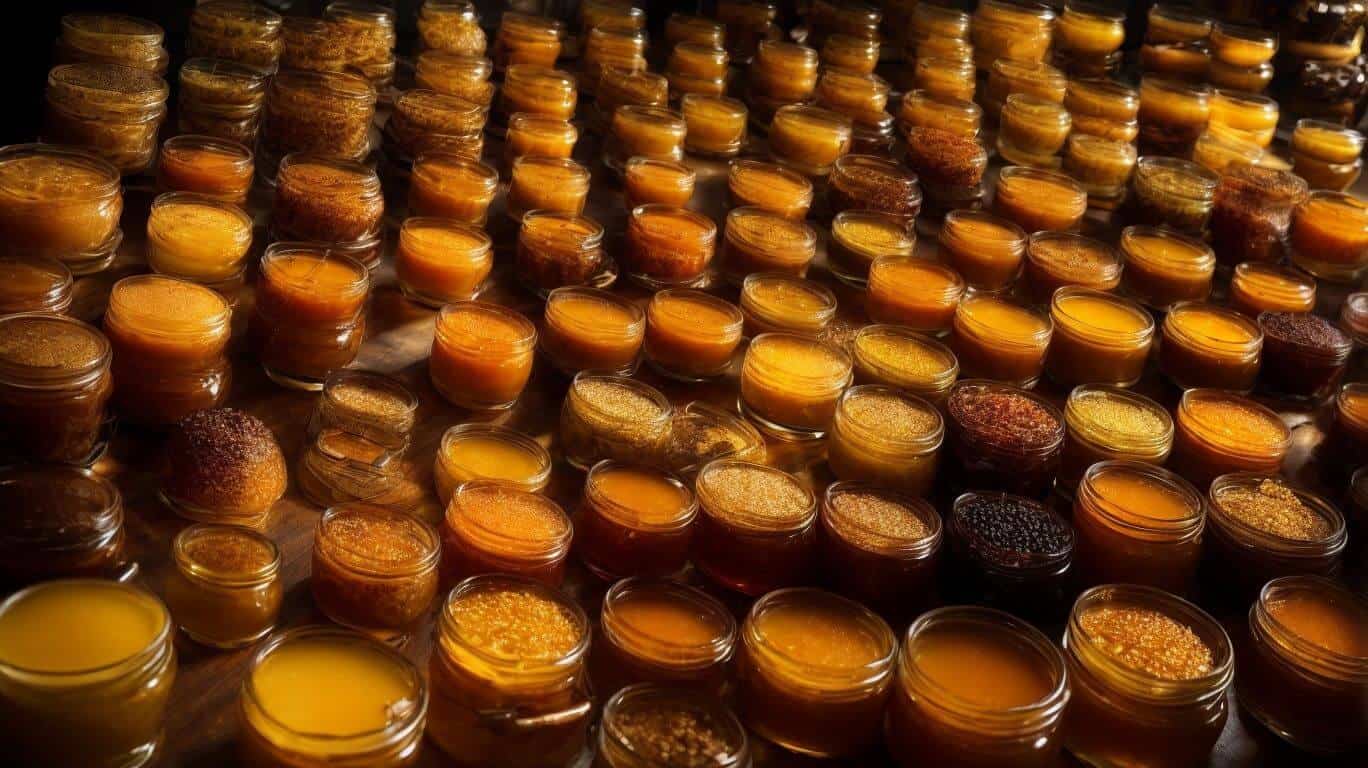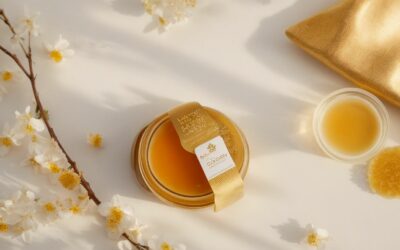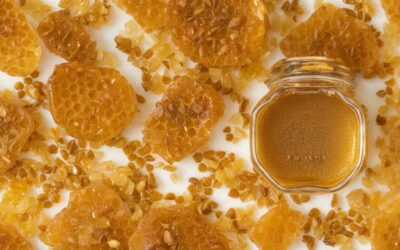Multifloral honey is made from the nectar of various types of flowers, while monofloral honey is made from the nectar of a single type of flower. Both types of honey have their distinct characteristics and benefits.
Ultimately, multifloral and monofloral honey have their benefits, and the choice between the two depends on your health goals and preferences. For general health benefits, multifloral honey may be a better choice as it contains a wider variety of nutrients. However, for specific health conditions, monofloral honey may be more effective, as certain compounds in specific types of flowers have been shown to have medicinal properties.
When choosing between multifloral and monofloral honey, here are some factors to consider:
Key Takeaways:
- Multifloral honey comes from a variety of flower sources, while monofloral honey is made from the nectar of a single type of flower.
- Monofloral honey has a more distinct flavor and aroma, while multifloral honey has a more complex and varied taste.
- Monofloral honey is more expensive due to its limited availability, but both types offer similar nutritional and medicinal benefits.
Multifloral Honey Vs Monofloral Honey – Different Types
Honey is a versatile and delicious food that comes in many different varieties. Among these varieties, multifloral honey and monofloral honey are two popular options. In this section, we will explore the different types of honey and focus specifically on the differences between multifloral and monofloral honey. Each type has unique characteristics and benefits, making them suitable for various purposes. Let’s delve into the world of honey and discover the distinctions between these two types.
1. Multifloral Honey
- Harvest: Multifloral honey is produced from the nectar of various types of flowers.
- Flavor and Aroma: It offers a complex, rich, and diverse flavor profile due to the diverse nectar sources.
- Nutritional Value: Contains a wide range of nutrients and antioxidants due to the variety of floral origins.
- Medicinal Properties: Provides a broad spectrum of health benefits due to the varied floral composition.
- Price: Generally more affordable than monofloral varieties due to the mixed floral sources.
2. Monofloral Honey
- Consider Your Health Goals: Determine if you seek specific benefits or general health improvements from Monofloral Honey.
- Check the Label and Source: Inspect labels for the honey’s floral source, origin, and purity.
- Taste Test: Sample the honey to appreciate its unique flavor profile and aroma.
- Budget: Compare prices to ensure the honey fits your budget.
A friend of mine, who is a nutritionist, swears by the benefits of Monofloral Honey. She once shared how incorporating it into her diet improved her overall well-being, especially her digestion and energy levels. It’s fascinating to see how such a simple addition can make a noticeable difference.
What Are the Differences Between Multifloral Honey and Monofloral Honey?
Honey is a beloved natural sweetener that comes in a variety of flavors and types. Two popular options are multifloral honey and monofloral honey. But what sets these two types of honey apart? In this section, we will discuss the key differences between multifloral honey and monofloral honey, including their source of nectar, flavor and aroma profiles, nutritional value, medicinal properties, and price. By the end, you’ll have a better understanding of which type of honey best suits your needs and preferences.
1. Source of Nectar
- Investigate the origin of nectar by examining the honey label or reaching out to the manufacturer for details about the specific floral or plant sources from which the bees gathered nectar.
- Comprehend the influence of the nectar source on the flavor, aroma, and potential health benefits of the honey.
- Take into account the geographical location and climate, as they play a role in determining the types of flowers that are available for nectar collection.
2. Flavor and Aroma
When differentiating between multifloral and monofloral honey, flavor and aroma are key factors to consider. Multifloral honey, which comes from a variety of nectar sources, offers a complex and rich flavor and aroma. On the other hand, monofloral honey, made from a single type of flower, provides a distinct and often intense flavor and aroma that is unique to that particular flower.
Pro-tip: For a versatile and nuanced flavor in cooking and baking, opt for multifloral honey, while monofloral honey is ideal for experiencing the pure essence of a specific flower’s nectar.
3. Nutritional Value
The nutritional value of honey varies based on its type and floral source. Multifloral honey may contain a diverse range of nutrients due to nectar from different flowers. In contrast, monofloral honey, like Manuka honey, is known for its specific nutritional properties, such as higher antibacterial benefits and antioxidant levels.
4. Medicinal Properties
- Antibacterial: Both multifloral and monofloral honey possess antibacterial properties due to their low water content and acidic pH, helping to prevent the growth of bacteria.
- Wound Healing: Studies suggest that honey, particularly monofloral varieties like Manuka, can aid in wound healing due to its high osmolarity and production of hydrogen peroxide.
- Anti-inflammatory: Certain types of honey, such as buckwheat honey, exhibit anti-inflammatory effects, potentially alleviating symptoms of inflammation-related conditions like sore throat.
- Medicinal Properties: In addition to its antibacterial, wound healing, and anti-inflammatory properties, honey has also been found to possess various other medicinal properties that can benefit overall health and well-being.
5. Price
- Consider Your Budget: Determine the price range you are comfortable with for purchasing honey.
- Evaluate Quality vs. Price: Compare the price of multifloral and monofloral honey against their respective quality and benefits.
- Explore Price Discrepancies: Research and understand the reasons behind price discrepancies in multifloral and monofloral honey.
- Vendor Options: Look for trusted vendors offering competitive prices for both multifloral and monofloral honey.
A friend of mine, a health enthusiast, conducted a blind taste test comparing the price of multifloral and monofloral honey to see if the higher price of monofloral honey is justified. Surprisingly, the multifloral honey emerged as her preferred choice due to its unique flavor profile and affordable price.
Which Type of Honey Is Better for You?
When it comes to honey, there are two main types: multifloral and monofloral. Both have their own unique characteristics and health benefits. In this section, we will discuss which type of honey is better for you. We’ll first explore the general health benefits of each type, and then delve into how they can specifically benefit those with certain health conditions. By the end, you will have a better understanding of which type of honey is best suited for your individual needs.
1. For General Health Benefits
- Consult a healthcare professional to understand how honey can contribute to your overall well-being.
- Choose raw, unprocessed multifloral honey for its diverse nutrient profile, including antioxidants and enzymes.
- Incorporate multifloral honey into your diet for its potential anti-inflammatory and immune-boosting properties.
- Be mindful of your sugar consumption, as honey, including multifloral varieties, still contains natural sugars.
2. For Specific Health Conditions
- Consult a healthcare professional: Before using honey for specific health conditions, it is important to seek advice from a healthcare provider to ensure compatibility with any ongoing treatment or medical conditions.
- Identify targeted benefits: Research the unique properties of multifloral and monofloral honey to determine which type best aligns with the specific health condition being addressed.
- Purchase from reliable sources: It is crucial to select reputable honey producers known for providing high-quality multifloral or monofloral honey that meets health requirements.
- Understand dosage and usage: It is essential to learn about the appropriate dosage and methods of incorporating honey into the diet for addressing specific health concerns.
How to Choose Between Multifloral Honey and Monofloral Honey?
When it comes to honey, there are many options to choose from, including multifloral and monofloral varieties. But how do you decide which one is right for you? In this section, we will discuss some key factors to consider when choosing between multifloral and monofloral honey.
From your health goals to the source and taste, we’ll cover everything you need to know to make an informed decision. So, let’s dive in and discover how to choose between these two types of honey.
1. Consider Your Health Goals
- Assess your specific health objectives, such as boosting immunity or managing allergies.
- Evaluate any dietary restrictions or requirements, like avoiding certain types of pollen.
- Consider any potential medicinal properties you seek in honey for overall well-being.
- Reflect on your taste preferences and how they align with the flavors of multifloral and monofloral honey.
- Factor in your budget and the affordability of the honey varieties in relation to your health goals.
A friend’s health goals led her to choose monofloral honey due to its reputed benefits for soothing throat irritation. Her regular consumption of this honey type has indeed alleviated her throat discomfort, aligning with her health objectives.
2. Check the Label and Source
- Make sure to check the label for the honey’s botanical and geographical origin.
- Verify the source by researching the brand’s transparency and ethical beekeeping practices.
- Look for certifications like USDA Organic or True Source Certified to ensure the authenticity of the honey.
- Examine the texture and color of the honey to determine its purity and potential processing methods.
Once, a friend shared how meticulously following these steps led them to discover a rare monofloral honey from a local beekeeper, greatly enhancing their culinary experiences.
3. Taste Test
- Take a small amount of multifloral honey and monofloral honey separately.
- Observe the color, texture, and aroma of each honey.
- Taste test the multifloral honey and take note of its unique flavor profile.
- Repeat the process with the monofloral honey for comparison.
When conducting a taste test between multifloral and monofloral honey, be sure to pay attention to the subtle differences in flavor, texture, and aroma to determine which best suits your personal preferences.
4. Budget
- Set a budget: Determine the amount you are willing to spend on honey based on your financial plan.
- Compare prices: Research various brands and types of honey to find options within your budget.
- Consider quantity: Assess the quantity of honey you need and how it aligns with your budget.
- Check for deals: Look for discounts, promotions, or bulk purchase options to make the most of your budget.
When choosing between multifloral and monofloral honey, prioritize quality and authenticity while staying within your budget.
Frequently Asked Questions
What is the difference between multifloral and monofloral Manuka honey?
Multifloral Manuka honey is sourced from multiple types of flowers, while monofloral Manuka honey comes from only one source – the Manuka tree. Monofloral honey is considered the most potent version of Manuka honey, while multifloral honey is more diluted.
What are the top benefits of Manuka honey?
Manuka honey is an incredible superfood with many healing properties. It can provide nutritional support, boost the immune system, and has powerful antibacterial and anti-inflammatory properties. It can also be used as a sugar substitute and is nutrient-rich.
Is one type of Manuka honey the right choice for everyday use?
Both multifloral and monofloral Manuka honey can be used on a daily basis. However, multifloral honey is better for everyday use due to its more affordable price and milder taste.
What is the UMF rating and how does it relate to monofloral Manuka honey?
The UMF (Unique Manuka Factor) rating is an independent grading system used to measure the potency of Manuka honey. Monofloral honey has a higher UMF rating due to its high level of potency from mainly Manuka pollen content.
Is one type of Manuka honey better for medicinal purposes?
Monofloral Manuka honey is recommended for medicinal purposes due to its higher potency and more limited availability. However, multifloral honey still has some healing properties and can be used as a daily supplement.
How can I ensure I am purchasing authentic Manuka honey?
When purchasing Manuka honey, make sure to check the label for the UMF rating and ensure it is from a registered member in New Zealand. The UMF grading is an important indicator of the authenticity and quality of the honey.
I’m a Manuka honey enthusiast and creator of Manuka Honey Organic, a blog where I share my journey with authentic Manuka honey from New Zealand. I want everyone to learn about the healing powers of Manuka honey.





